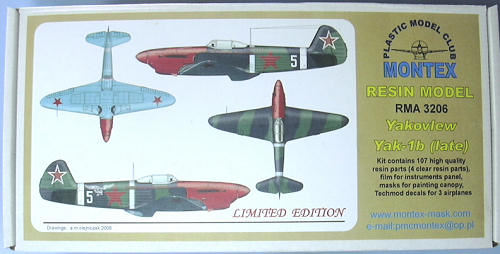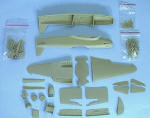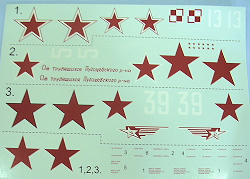
Montex 1/32 Yak-1b
| KIT #: | RMA3206 |
| PRICE: | $179.95 MSRP |
| DECALS: | Three options |
| REVIEWER: | Tom Cleaver |
| NOTES: | Resin kit |

| HISTORY |
Design of what became the Yak-1 commenced in 1938
in response to an official requirement for the development of a new sing-seat
fighter as the result of a design competition, as the Soviets belatedly began
updating their military equipment in the shadow of German aggression.
The then-little-known Alexander Yakovlev entered the competition with
the I-26, which was adjudged the most promising of those submitted. The
prototype I-26 was built of wood, and powered by the M-105, a license-built
version of the Hispano-Suiza 12Y, and first flew in March, 1939.
The aircraft received the designation Yak-1 shortly thereafter and
work began on a pre-production batch of fighters for further development.
Most of the defects testing discovered had been rectified by early
1941 and was cleared for mass production in June 1941.
, The development of the Yak-1 was so successful that it earned
Yakovlev the 100,000-ruble Lenin Prize and a Zis automobile on April 27, 1939.
Due to the German attack and the need to remove
the factory from Moscow to the Urals in the fall of 1941, appreciable numbers of
Yak-1s did not begin to reach operational units of the V-VS in worthwhile
numbers until the Spring of 1942.
The Yak-1b, powered by the M-105PF engine
producing 1,200 h.p. and distinguishable by a cut-down rear fuselage and
all-round vision canopy, began production in late 1942. The Yak-1b was for many
years known in the West as the Yak-1M. It is now known that the Yak-1M
designation was given to only two airplanes, the prototypes of what became the
Yak-3 series.
The twin Beresin UBS 7.62mm machine guns of the Yak-1 were replaced by a
single Beresin UBS 13mm machine gun, with the 20mm hub cannon retained. This
aircraft was introduced to combat in 1943, as was produced alongside and served
beside the earlier version, as well as remaining in production and service use
while “later” versions entered production.
Simple to build in quantity, rugged, and possessing superlative flying characteristics, the Yak fighters were superior to anything else at low to medium altitudes. The series was built in larger numbers than all other Soviet fighters used during the war combined, with a total production in excess of 30,000 between 1941 and 1945. Due to the inadequately power of the M-105 series of engines, which left much to be desired in terms of altitude performance, the Yaks were lightly armed by either German or Allied standards.
| THE KIT |
 This Yak-1b is the sixth all-resin kit produced
by Montex, and furthers the company’s reputation for excellence in design and
production of an all-resin kit.
In fact, these resin kits are serious competition to those released by
Fisher Models for design and production quality.
This Yak-1b is the sixth all-resin kit produced
by Montex, and furthers the company’s reputation for excellence in design and
production of an all-resin kit.
In fact, these resin kits are serious competition to those released by
Fisher Models for design and production quality.
The kit has separate control surfaces including
flaps, and the overall d
As with the other kits, a very fully-detailed
cockpit is provided.
The three-part clear resin canopy is also very remarkable for its
crispness and clarity.
Decals are provided for three different aircraft, two of which are in the green-black-light blue camouflage, one with the nose in red, while the third is in the dark grey-green/light grey/light blue later style of camouflage.
| CONCLUSIONS |
Another winner from Montex.
For what you get, the price is very reasonable.
As they say about a good movie, “it’s all up there on the screen.”
The design is so good that a modeler could only screw up the kit by
throwing it against a brick wall or dropping it out of a window onto concrete.
This is the kind of model that will make an average modeler good and a
good modeler great.
Anyone who has done at least one or two all-resin kits will have no
trouble with this kit.
Thanks to Montex for the review kit.
March 2009
If you would like your product reviewed fairly and quickly, please contact me or see other details in the Note to Contributors.